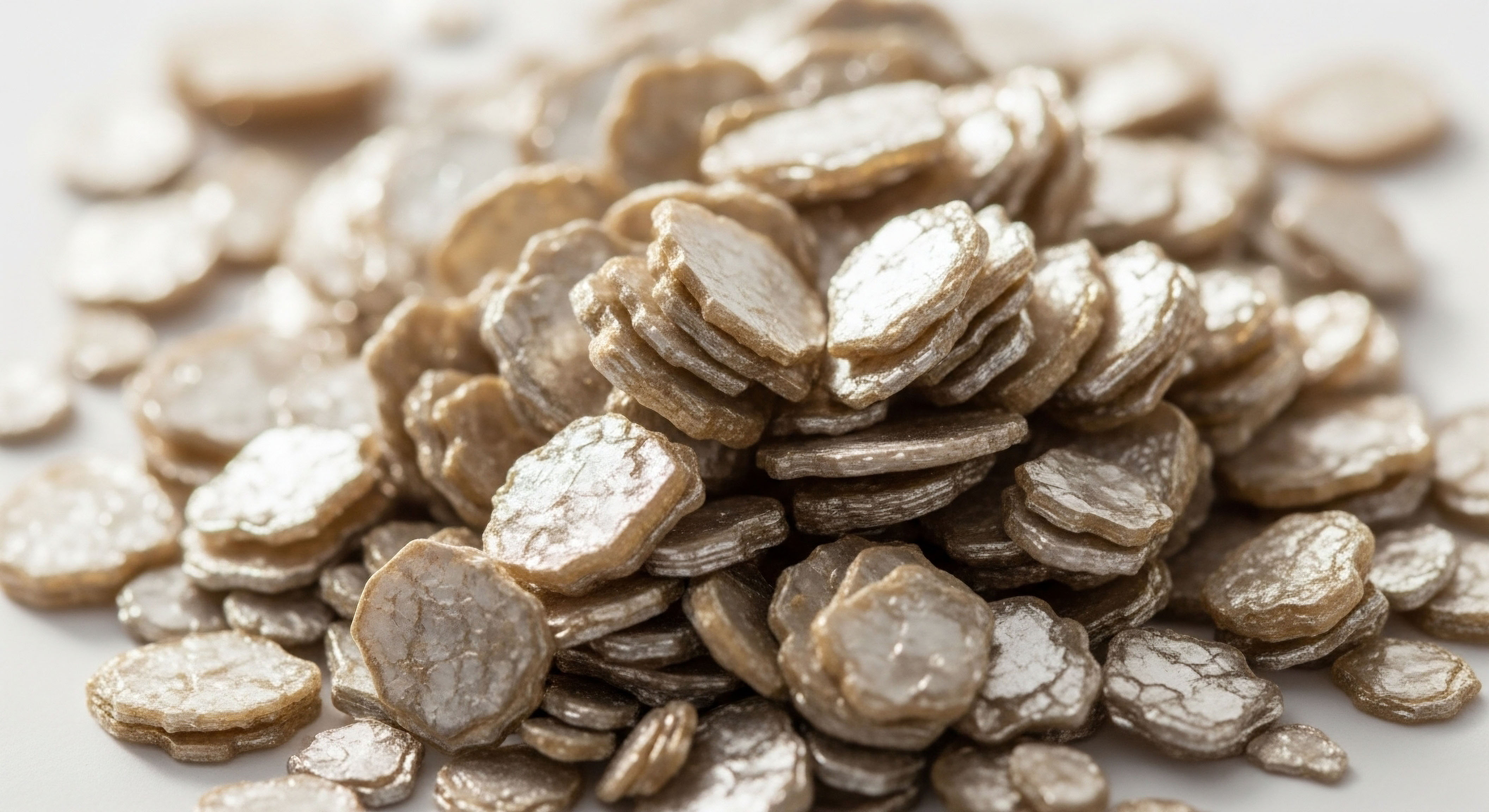

Fundamentals
Your experience of your own body is the ultimate authority. When changes occur, especially within the intricate hormonal systems that govern vitality, the feeling of being disconnected from your own biological processes is a common and valid starting point.
The question of whether something as fundamental as diet can influence cellular activity in the prostate is not just a scientific inquiry; it’s a deeply personal one. It stems from a desire to reclaim a sense of agency over your health. The answer, grounded in clinical science, is a clear and resounding yes.
Dietary choices can and do modulate the activity of the androgen receptor (AR) in prostate cells, and understanding this mechanism is the first step toward a more empowered health journey.
The androgen receptor is a protein found inside cells, including those of the prostate gland. Think of it as a highly specific docking station. Its primary role is to bind with androgens, the male hormones, most notably testosterone and its more potent form, dihydrotestosterone (DHT).
When an androgen docks with its receptor, the entire complex moves into the cell’s nucleus, the command center, where it attaches to DNA. This binding event initiates a cascade of instructions, telling the cell to grow, divide, or produce specific proteins like prostate-specific antigen (PSA). This is a normal, healthy process essential for the development and function of the prostate. The modulation of this receptor’s activity through diet is a direct intervention in this fundamental biological conversation.
Dietary compounds can directly influence the sensitivity and activity of androgen receptors in prostate cells, altering hormonal signaling at a cellular level.

The Cellular Environment and Hormonal Dialogue
The activity of the androgen receptor is not solely dependent on the amount of available androgens. The cellular environment in which the receptor operates plays a significant role. This environment is profoundly influenced by the nutrients, or lack thereof, that we consume. Specific dietary compounds can interact with this system in several ways.
Some may reduce the number of available androgen receptors on the cell surface. Others might interfere with the binding process between the androgen and the receptor. A third mechanism involves disrupting the translocation of the androgen-receptor complex into the nucleus, effectively preventing the signal from being delivered. These are not abstract concepts; they are tangible biological events occurring within your body, influenced by your nutritional intake.
This understanding shifts the conversation from one of passive observation to one of active participation. Your dietary choices become a form of communication with your own cells. You are providing the raw materials that can either amplify or temper the hormonal signals that drive cellular behavior.
This is the foundational principle of using diet as a tool for personalized wellness. It is about creating a biological environment that supports optimal function and discourages the cellular activities that can lead to dysfunction over time. The journey begins with appreciating that the food you consume is a constant source of molecular information for your body’s intricate systems.


Intermediate
Moving beyond the foundational understanding that diet influences hormonal signaling, we can examine the specific mechanisms through which dietary compounds modulate androgen receptor (AR) activity. This is where the “how” becomes clear, revealing the elegant interplay between nutrition and cellular physiology.
The modulation of the AR is not a single event but a series of potential interventions in a complex signaling pathway. Different dietary components target different steps in this pathway, offering a multi-pronged approach to influencing prostate cell behavior.

Phytochemicals as Signal Modulators
Certain plant-derived compounds, known as phytochemicals, have a molecular structure that allows them to interact with hormonal pathways. These compounds can act as selective androgen receptor modulators (SARMs), meaning they can either block or weakly activate the receptor depending on the specific tissue and cellular context. This nuanced action is key to their potential benefits.

Isoflavones from Soy
Soy products contain isoflavones like genistein and daidzein, which are structurally similar to estrogen. Because of this similarity, they can bind to estrogen receptors, particularly estrogen receptor-beta (ER-β), which is predominant in the prostate. Activating ER-β has been shown to downregulate the expression of the androgen receptor itself, effectively reducing the number of “docking stations” available for androgens.
Furthermore, some research indicates that genistein can promote the degradation of the AR, further reducing its presence in the cell. This dual action ∞ reducing AR expression and promoting its breakdown ∞ is a powerful example of dietary modulation.

Lycopene from Tomatoes
Lycopene, the carotenoid that gives tomatoes their red color, operates through a different but complementary mechanism. Studies have shown that lycopene can inhibit the activity of the androgen receptor gene element in a dose-dependent manner. This means it interferes with the AR’s ability to activate genes once it has entered the cell’s nucleus.
It can also reduce the expression of the AR, making cells less sensitive to androgenic signals. Combining lycopene with certain medical therapies has been shown to enhance their effectiveness by down-regulating key signaling pathways that involve the AR.
Specific phytochemicals, such as genistein and lycopene, can decrease the expression and functional activity of the androgen receptor through distinct biochemical pathways.

The Role of Cruciferous Vegetables
Cruciferous vegetables like broccoli, cauliflower, and Brussels sprouts are rich in a compound called sulforaphane. The action of sulforaphane on the AR is a prime example of indirect modulation. It does not target the AR directly. Instead, it inhibits an enzyme called histone deacetylase 6 (HDAC6).
HDAC6 is responsible for the proper functioning of a chaperone protein called HSP90. HSP90’s job is to stabilize the androgen receptor, protecting it from degradation and ensuring it is ready to bind with androgens. By inhibiting HDAC6, sulforaphane causes a chemical change in HSP90 (hyperacetylation), which impairs its ability to chaperone the AR.
As a result, the androgen receptor becomes unstable, dissociates from HSP90, and is subsequently degraded by the cell’s waste disposal system (the proteasome). This leads to a lower overall level of AR protein in the cell, reduced expression of AR-regulated genes, and a blunted response to androgens.
This mechanism showcases the sophisticated, systems-level impact of dietary compounds. It’s a chain reaction ∞ a nutrient affects an enzyme, which affects a chaperone protein, which in turn destabilizes a hormone receptor, ultimately altering the cell’s genetic expression.
The following table outlines the primary mechanisms of action for these key dietary compounds:
| Compound | Primary Source | Mechanism of AR Modulation |
|---|---|---|
| Genistein | Soy products | Downregulates AR gene expression via ER-β activation; promotes AR degradation. |
| Lycopene | Tomatoes | Inhibits AR gene element activity; may reduce AR expression. |
| Sulforaphane | Cruciferous vegetables | Inhibits HDAC6, leading to HSP90 hyperacetylation and subsequent AR destabilization and degradation. |


Academic
An academic exploration of dietary modulation of androgen receptor (AR) activity requires a deep dive into the molecular biology of the AR signaling cascade and the specific interactions of dietary compounds with this pathway.
The AR is a ligand-activated transcription factor, and its function is governed by a series of post-translational modifications, protein-protein interactions, and subcellular trafficking events, all of which present potential targets for intervention. Dietary phytochemicals can influence these processes with a high degree of specificity, altering the transcriptional output of androgen-responsive genes.

Transcriptional and Post-Translational Regulation by Phytochemicals
The impact of dietary compounds extends beyond simple receptor blockade. These molecules can initiate complex intracellular signaling events that culminate in the altered expression and function of the androgen receptor. This is a level of biological control that goes to the very heart of cellular regulation.

Genistein and AR Gene Repression
The isoflavone genistein provides a compelling case study in multi-level AR regulation. While its ability to downregulate AR expression via estrogen receptor-beta (ER-β) is well-documented, its influence on the AR protein itself is also significant.
Genistein has been shown to interfere with the heat shock protein (HSP) machinery that is essential for the correct folding and stability of the AR. By disrupting the AR-HSP90 complex, genistein can tag the receptor for proteasomal degradation, effectively clearing it from the cell.
In some cellular contexts, particularly in androgen-sensitive cells, even low concentrations of genistein can reduce the transcription of AR-dependent genes like PSA. This suggests a direct or indirect effect on the transcriptional machinery or the AR’s ability to recruit co-activator proteins necessary for gene expression.

Sulforaphane and HDAC6-Mediated AR Destabilization
The mechanism of sulforaphane is a clear example of targeting a critical node in the AR stability pathway. The histone deacetylase 6 (HDAC6) enzyme is a cytoplasmic deacetylase whose substrates include α-tubulin and the molecular chaperone HSP90. The proper chaperone function of HSP90 is ATP-dependent and requires a cyclical process of client protein binding and release.
This process is modulated by the acetylation status of HSP90. When HDAC6 is active, it deacetylates HSP90, maintaining its high affinity for client proteins like the AR. Sulforaphane directly inhibits the enzymatic activity of HDAC6. This inhibition leads to the accumulation of acetylated HSP90.
Acetylated HSP90 has a crippled chaperone function and releases its client proteins, including the AR. The unbound AR is conformationally unstable and is rapidly ubiquitinated and degraded by the 26S proteasome. This depletion of the cellular AR pool has profound downstream effects, reducing the expression of AR target genes and attenuating the entire androgen signaling axis.
The molecular actions of compounds like sulforaphane and genistein demonstrate that dietary interventions can regulate androgen receptor stability and transcriptional activity through sophisticated post-translational and epigenetic mechanisms.

The Role of Micronutrients in the Hormonal Milieu
While phytochemicals often take center stage, essential micronutrients like zinc and selenium also play a critical, albeit complex, role in modulating the androgen signaling environment. Their effects are often interdependent and can be dose-dependent, highlighting the need for a balanced approach.
- Zinc ∞ Zinc is highly concentrated in the prostate gland and is essential for its normal function. Research has shown that zinc status can influence androgen receptor levels. Studies in animal models have indicated that zinc supplementation alone can lead to an increase in serum testosterone concentrations and a corresponding increase in AR protein expression in the prostate. This suggests that zinc is a necessary component for maintaining the integrity of the androgen signaling axis. It is believed to play a role in the structural integrity of the AR protein itself, which contains zinc-finger motifs in its DNA-binding domain.
- Selenium ∞ Selenium, typically in the form of selenoproteins, functions as a critical antioxidant in the prostate, protecting against oxidative stress that can damage cellular components, including DNA and proteins like the AR. Interestingly, when zinc and selenium are administered together, the zinc-induced increase in AR expression is often negated. This suggests an antagonistic relationship in this specific context, where selenium may modulate the effects of zinc on the AR. This interaction underscores the complexity of micronutrient synergy and the importance of balance in supplementation protocols.
The following table details the nuanced effects of these micronutrients on androgen signaling:
| Micronutrient | Observed Effect on Androgen System | Potential Mechanism |
|---|---|---|
| Zinc (alone) | Increased serum testosterone and prostate AR expression in animal models. | Structural component of the AR’s DNA-binding domain; cofactor for enzymes in steroidogenesis. |
| Selenium (with Zinc) | Antagonizes the zinc-induced increase in AR expression. | Modulation of zinc’s metabolic effects; antioxidant protection of the cellular environment. |

How Does Dietary Intervention Compare to Pharmaceutical Approaches?
Dietary interventions modulate AR activity through pleiotropic mechanisms, often with a broader, more systemic effect compared to the highly targeted action of pharmaceuticals. While drugs like enzalutamide are designed for high-affinity competitive inhibition of the AR, dietary compounds like sulforaphane or genistein work by altering the cellular environment, reducing AR protein levels, and influencing multiple signaling pathways simultaneously.
This multi-targeted approach may offer a complementary strategy, potentially enhancing the efficacy of conventional therapies or contributing to a preventative cellular milieu that is less conducive to AR-driven proliferation.

References
- Zhang, X. Wang, Q. & Neil, B. (2013). Effect of lycopene on androgen receptor and prostate-specific antigen velocity. Chinese Medical Journal, 126(18), 3493-7.
- van Die, M. D. Bone, K. M. Williams, S. G. & Pirotta, M. V. (2017). The Use of Soy Isoflavones in the Treatment of Prostate Cancer ∞ A Focus on the Cellular Effects. MDPI.
- Gibbs, A. Schwartzman, J. Deng, V. & Alumkal, J. (2009). Sulforaphane destabilizes the androgen receptor in prostate cancer cells by inactivating histone deacetylase 6. Proceedings of the National Academy of Sciences, 106(39), 16663-8.
- Singh, S. V. & Singh, P. (2009). d,l-Sulforaphane causes transcriptional repression of androgen receptor in human prostate cancer cells. Cancer Research, 69(14), 5892-900.
- Pihlajamaa, P. Zhang, F. P. Saarinen, L. Mikkonen, L. Hautaniemi, S. & Jänne, O. A. (2011). Phytoestrogen Genistein Is a Tissue-Specific Androgen Receptor Modulator. Endocrinology, 152(11), 4395 ∞ 4405.
- Daragó, A. Klimczak, M. Stragierowicz, J. Stasikowska-Kanicka, O. & Kilanowicz, A. (2020). The Effect of Zinc, Selenium, and Their Combined Supplementation on Androgen Receptor Protein Expression in the Prostate Lobes and Serum Steroid Hormone Concentrations of Wistar Rats. Nutrients, 12(1), 153.
- Christudoss, P. Selvakumar, R. & Pulimood, A. B. (2011). The effect of zinc on the distribution and antioxidant enzyme activities in the prostate of the rat. Indian Journal of Physiology and Pharmacology, 55(2), 180-5.

Reflection

What Does This Mean for Your Personal Health Protocol?
The information presented here provides a map of the biological terrain. It illustrates the profound connection between your nutritional choices and the complex inner workings of your cells. This knowledge is the foundation upon which a truly personalized wellness strategy is built.
Seeing how specific compounds can influence hormonal signaling pathways transforms the act of eating from a daily necessity into a powerful opportunity for biological communication. Your journey forward involves translating this scientific understanding into a practical, sustainable approach that aligns with your individual biology, goals, and lived experience. The path to reclaiming vitality is paved with informed choices, and it begins with the understanding that you are an active participant in the story of your own health.



